
Wood fences are not only functional, but they can also be a beautiful addition to your property. However, over time, the wood fence can become weathered and worn, diminishing its appearance and compromising its structural integrity. That's where staining comes in. By staining your wood fence, you can enhance its natural beauty, protect it from weather damage, and extend its lifespan.
One of the main reasons to stain your wood fence is to enhance its appearance. Stain can bring out the natural color and grain of the wood, giving your fence a beautiful, rich look. Whether you choose a clear stain to highlight the wood's natural beauty or a colored stain to match your outdoor decor, staining can transform your fence into a stunning focal point.
Another important reason to stain your wood fence is to protect it from weather damage. Wood is susceptible to rot, warping, and cracking when exposed to the elements. By applying a protective stain, you create a barrier that shields the wood from rain, snow, and harmful UV rays. Stain can also prevent the growth of mold, mildew, and other fungi that can damage the wood over time.
By staining your wood fence, you can significantly increase its lifespan. Stain helps to seal the wood, preventing moisture from penetrating the surface and causing decay. With proper care and maintenance, a stained wood fence can last for many years, saving you the time and expense of frequent repairs or replacements.
The first and most important supply you'll need is the stain itself. There are a variety of stains available, so choose one that is specifically designed for use on wood fences. Consider factors such as stain color, transparency, and compatibility with the wood's natural grain. You should also know how much stain you need for your project.
Before staining your fence, it's important to thoroughly clean the surface to remove dirt, debris, and any existing stain or sealant. A fence cleaner specifically formulated for wood surfaces can effectively remove grime and prepare the fence for staining.
You'll also need a brush or sprayer to apply the stain. A brush allows for precise application, especially when dealing with intricate details or hard-to-reach areas. On the other hand, a sprayer can cover large areas quickly and easily, making it an efficient option for larger fences.
The first step in preparing your wood fence for staining is to clean the surface. Use a fence cleaner and a brush or power washer to remove dirt, grime, and any existing stain or sealant. Work in small sections and follow the manufacturer's instructions for best results.
Inspect your wood fence for any damaged or rotten boards. If you find any, it's recommended to repair or replace them before staining. Damaged wood can affect the overall look and integrity of your fence, so make sure to address any issues before proceeding with the staining process.
Before you start staining your fence, take the time to protect any nearby plants, grass, or other surfaces that you don't want to get stained. Use plastic sheets or drop cloths to cover these areas and prevent any accidental splatters or drips.
When using a brush to apply the stain, start at the top of the fence and work your way down, brushing in the direction of the wood grain. Apply a generous amount of stain to saturate the wood, allowing it to penetrate deeply. Make sure to back-brush as you go to ensure an even application and to remove any excess stain.
If you choose to use a sprayer, make sure to set it to the appropriate nozzle and adjust the spray pattern as needed. Hold the sprayer at a consistent distance from the fence boards and move in a smooth, sweeping motion to ensure even coverage. Take care not to overspray or miss any areas.
For a quick and easy way to stain your fence, you can also use a roller. Dip the roller in the stain and roll it vertically along the fence boards, working in sections. Repeat the process as needed until the wood is adequately coated. Use a brush to back-brush and remove any excess stain or uneven spots.
To keep your stained wood fence looking its best, it's important to perform regular cleaning and inspections. Use a mild detergent and water to clean the surface, removing any dirt or grime. Inspect the fence for any signs of wear, damage, or fading and address any issues promptly.
Over time, the stain on your wood fence may begin to fade or wear away in certain areas. To maintain a consistent appearance, consider touching up the stain as needed. Clean the area thoroughly, apply a small amount of stain with a brush, and blend it into the surrounding stained areas.
To further protect your stained wood fence and prolong its lifespan, consider sealing the stain. A clear sealant can provide an additional layer of defense against moisture, UV rays, and other potentially damaging elements. Follow the manufacturer's instructions for applying the sealant and allow it to fully cure before exposing the fence to harsh weather conditions.
Staining your wood fence is a great way to enhance its beauty and protect it from the elements. With these tips on how to prepare, apply, and maintain your stained wood fence, you can ensure a beautiful and long-lasting finish that will last for years to come. For additional assistance with staining and other fencing services in Los Angeles, contact Los Angeles Fence Builders today.